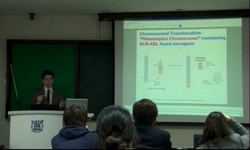CHAPTER TWO Polychlorinated biphenyl (PCB) exposures are associated with decreased gestation length in women and spontaneous abortion in non-human primates. To maintain pregnancy to term, the quiescence of uterine smooth muscle activity is necessary...
http://chineseinput.net/에서 pinyin(병음)방식으로 중국어를 변환할 수 있습니다.
변환된 중국어를 복사하여 사용하시면 됩니다.
- 中文 을 입력하시려면 zhongwen을 입력하시고 space를누르시면됩니다.
- 北京 을 입력하시려면 beijing을 입력하시고 space를 누르시면 됩니다.
POSSIBLE MECHANISMS BY WHICH THE PCB MIXTURE AROCLOR 1242 STIMULATES TES PREGNANT RAT UTERINE OSCILLATORY CONTRACTION
한글로보기https://www.riss.kr/link?id=T8984037
- 저자
-
발행사항
[Michigan] : University of Michigan, 1998
-
학위논문사항
Thesis(doctoral) -- The University of Michigan , Toxicology , 1998
-
발행연도
1998
-
작성언어
영어
-
주제어
MECHANISMS ; PCB ; MIXTURE ; AROCLOR ; 1232 STIMULATES ; TES ; PREGNANT ; RAT ; UTERINE ; OSCILLATORY ; CONTRACTION
-
KDC
513 판사항(4)
-
발행국(도시)
Michigan
-
형태사항
xii, 177 p. ; 26cm.
- 소장기관
-
0
상세조회 -
0
다운로드
부가정보
다국어 초록 (Multilingual Abstract)
CHAPTER TWO
Polychlorinated biphenyl (PCB) exposures are associated with decreased gestation length in women and spontaneous abortion in non-human primates. To maintain pregnancy to term, the quiescence of uterine smooth muscle activity is necessary. We examined whether PCBs could augment spontaneous oscillatory contractions of pregnant rat uteri as a possible mechanism for early onset of parturition. Isometric contractions of pregnant rat uterine, longitudinal muscle strips were monitored using standard muscle baths interfaced with a polygraph. Recent studies show that the less chlorinated PCB congeners exert the greatest acute effects on uterine contractions. Therefore, we hypothesized that the ability of PCB mixtures to modulate uterine spontaneous oscillatory contraction would increase with decreased chlorine content. The PCB mixtures Aroclor 1242 (A1242), 1248 (A1248), and 1254 (A1254) were selected for study, because these mixtures were more heavily used in industry. Additionally, bacteria isolated from the Hudson River were incubated with A1242 and A1254, and uterine segments were exposed to the PCB bacterial degradation products HR1242 and HR1254. The composition of the PCB mixtures after incubaton with bacteria consisted of less chlorinated PCBs than the respective parent Aroclors. All of the PCB mixtures stimulated uterine contractions in a concentration-dependent manner when each Aroclor was added to the muscle bath in a cumulative manner at 20-min intervals. Contraction force was not affected, but contractile frequency increased significantly. To determine the effect of exposure time on uterine contraction, uterine strips were exposed to three concentrations of A1242 (10, 50, and 100μM) for 60 min. The frequency of uterine contractions increased as the duration of exposure increased. In order to study reversibility, after a 60min exposure to a single concentration of A 1242, strips were rinsed three times to remove A1242 from the bath. Even after rinsing, the frequency of contraction remained elevated for at least 4 hr, indicating poor reversibility. These data show that A1242, A1248, A1254, HR1242 and HR1254 stimulated pregnant rat uterine contraction in a concentration-dependent manner, and that decreased chlorine content of the PCB mixtures was associated with increased uterine stimulation. Also, A1242 stimulated uterine contraction in an exposure duration-dependent manner, and this response was not readily reversible. Therefore, this study suggests that PCBs as environmental contaminants may decrease gestation length by augmenting uterine oscillatory contraction.
CHAPTER THREE
Previously, we showed that the PCB mixture Aroclor 1242 (A1242) increases frequency of contractions of pregnant rat uteri as a possible mechanism for decrease of gestational age and occurrence of spontaneous abortion in women and animals exposed to PCBs. In the present study, the role of arachidonic acid (AA) as a mediator of the uterotonic effect of A1242 was investigated. We hypothesized that A1242-induced stimulation of uterine contraction is mediated by AA released by action of phospholipase A₂(PLA₂) enzymes. Isometric uterine contraction was measured in longitudinal uterine smooth muscle strips isolated from gestation day 10 rat. Pretreatment of uterine strips with the PLA₂ inhibitor HELSS or manoalide, or an inhibitor of the G-protein of PLA₂, isotetrandrine, completly prevented the increase of contractile frequency induced by 50μM A1242. In addition, release of AA by phospholipase C (PLC) enzymes was studied using the PLC inhibitors 2-nitro-4-carboxyphenyl-N,N-diphenylcarbamate (NCDC) and neomycin. However, the PLC inhibitors were not able to block stimulation of uterine contraction by A1242. In accordance, A1242 (100μM) did not release inositol phosphates from myo-[³H]-inositol labeled myometrial cells. Additionally, myometrial cells prelabeled with ³H-AA released AA in a concentration- and time-dependent manner after exposure to 10 to 100μM A1242. A242 significantly stimulated AA release in the absence of extracellular calcium, although the release was attenuated. Analysis of the eicosanoids released by A1242 indicated that only 0.83% of released ³H-AA was metabolized to eicosanoids and 99.07% remained as free AA. These data suggest that AA, rather than eicosanoids, may mediate A1242 action in the uterus. Addition of exogenous AA (1-100μM) showed concentration-dependent increases of uterine contraction. Therefore, this study suggests that A1242 stimulates pregnant uterine contraction by a mechanism that involves AA released by the action of PLA₂.
CHAPTER FOUR
Polychlorinated biphenyls (PCBs) are persistant environmental pollutants associated with spontaneous abortion and shortened gestation length in women and animals. In previous studies, we showed that PCB mixtures and non-coplanar ortho-substitued PCB congeners increased pregnant rat uterine contractions. In the present study, we investigated the possible machanism by which the PCB Mixture Aroclor 1242 (A1242) stimulates pregnant uterine contraction. Calcium is pivotal in uterine muscle contraction, like other muscles, and increased [Ca^(2+)]_i by PCB exposures were observed with other cell types. Therefore, we hypothesized that A1242-induced stimulation of uterine contraction is mediated by increased intracellular calcium. The role of calcium in A1242-induced stimulatory effect on uterine contraction was examined using pharmacological agents that modulate calcium availability. Pretreatments of muscle strips with 5μM ryanodine or 1μM thapsigargin, to deplete Ca^2(+)-induced Ca^(2+) release (CICR) or IP₃-induced Ca^(2+) release (IICR) stores, respectively, did not prevent the stimulated uterine contraction by 50μM A1242, whereas thapsigarginn effectively blocked carbachol-induced stimulation of uterine contraction. However, even 100μM A1242 was not able to increase contraction in the absence of extracellular calcium or in the presence of the voltage-operated L-type calcium channel blocker nifedipine (10μM). Because these data suggest the involvement of activation of voltage-operated calcium channels (VOCC) in A1242-induced stimulation of contraction, the ability of A1242 to depolarize the membrane was determined using a. potential-sensitive carbocyanine dye. A1242 (100μM) partially depolarized the cell membrane of myometrial cells from pregnant rats. Using the fluorescent calcium-sensitive probe fura-2, changes of [Ca^(2+)]_i by A1242 were monitored in single myometrial cells. Cells exposed to 100μM A1242 showed a delayed and sustained increase of [Ca^(2+)]_i, and its increase was completely blocked in the absence of extracellular calcium or the presence of nifedipine (10μM). Therefore, the data suggest that depolarization of the cell membrane by A1242 enabled myometrial cells to increase [Ca^(2+)]_i through activation of VOCC, and the increased [Ca^(2+)]_i, consequently, stimulated contraction of uterine smooth muscle.
목차 (Table of Contents)
- DEDICATION = II
- ACKNOWLEDGMENT = III
- LIST OF FIGURES = VI
- LIST OF TABLES = VIII
- LIST OF ABBREVIATIONS = IX
- DEDICATION = II
- ACKNOWLEDGMENT = III
- LIST OF FIGURES = VI
- LIST OF TABLES = VIII
- LIST OF ABBREVIATIONS = IX
- CHAPTER ONE:INTRODUCTION = 1
- References - Introduction = 7
- CHAPTER TWO:PCB MIXTURES AND THEIR MICROBIAL DECHLORINATED PRODUCTS STIMULATE SPONTANEOUS OSCILLATORY CONTRACTIONS OF PREGNANT RAT UTERI = 22
- Summary = 22
- Introduction = 24
- Materials and Methods = 26
- Results = 30
- Discussion = 33
- Acknowledgments = 36
- References - Chapter Two = 37
- CHAPTER THREE:STIMULATION OF PREGNANT RAT UTERINE CONTRACTION BY THE PCB MIXTURE AROCLOR 1242 MAY BE MEDIATED BY ARACHIDONIC ACID RELEASE THROUGH ACTIVATION OF PHOSPHOLIPASE A₂ ENZYMES = 56
- Summary = 56
- introduction = 57
- Materials and Methods = 59
- Results = 66
- Discussion = 73
- Acknowledgments = 79
- References - Chapter Three = 80
- CHAPTER FOUR STIMULATION OF PREGNANT UTERINE CONTRACTION BY THE PCB MIXTURE AROCLOR 1242 MAY INVOLVE INCREASED [Ca^(2+1]_i THROUGH VOLTAGE-OPERATED CALCIUM CHANNELS = 103
- Summary = 103
- Introduction = 104
- Materials and Methods = 107
- Results = 113
- Discussion = 118
- Acknowledgments = 123
- References - Chapter Four = 124
- CHAPTER FIVE:CONCLUSION = 143
- References - Conclusion = 160
- APPENDIX = 171












